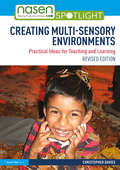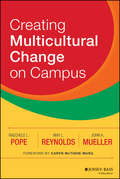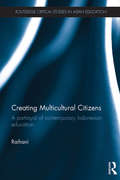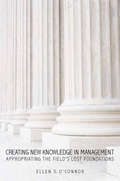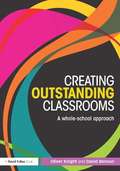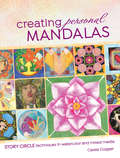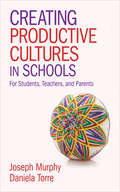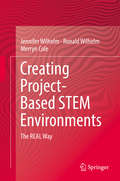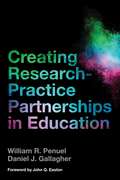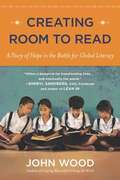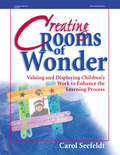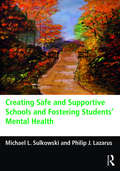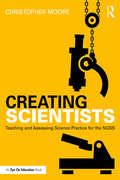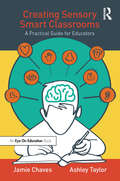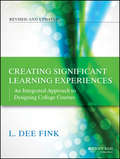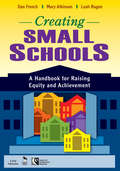- Table View
- List View
Creating Multi-sensory Environments: Practical Ideas for Teaching and Learning (nasen spotlight)
by Christopher DaviesThe revised edition of this highly practical guide to creating and using multi-sensory environments is packed full of ideas for low-cost, easy to assemble multi-sensory environments suitable for children of varying ages and abilities. Each creative learning environment is designed to be constructed in a classroom or school hall, encouraging creative thinking and learning, and development of social and emotional skills. Each environment idea is accompanied by suggestions for use for children with special educational needs. Key features of the revised edition include: Ideas for creating sensory experiences that stimulate all the sensory channels – auditory, visual, kinaesthetic, olfactory and gustatory Suggestions for extension or differentiation depending on student capability or time available A summary of the theory and background to multi-sensory learning, to allow you to adapt the suggested scenarios according to the needs of individual learners Although these activities will be of particular value for children with special educational needs or sensory impairments, they are more broadly designed to provide stimulating learning environments, as promoted in the themes and principles of the Early Years Foundation Stage Guidance. This is an invaluable resource for teachers and other professionals in education.
Creating Multicultural Change on Campus
by Raechele L. Pope Amy L. Reynolds John A. Mueller Caryn Mctighe MusilEmbrace the best practices for initiating multicultural change in individuals, groups, and institutionsHigher education institutions have begun to take steps toward addressing multicultural issues on campuses, but more often than not, those in charge of the task have received little to no training in the issues that are paramount in serving culturally diverse students. Creating Multicultural Change on Campus is a response to this problem, offering new conceptualizations and presenting practical strategies and best practices for higher education professionals who want to foster the awareness, knowledge, and skills necessary for multicultural change on an institutional level. In Creating Multicultural Change on Campus, the authors of the classic text Multicultural Competence in Student Affairs delve deep into key concepts in multicultural organizational development, guiding readers who want to enact change not just at the individual level, but also at the group and institutional levels.Readers will be introduced to frameworks that are crucial for creating inclusive, welcoming, and affirming campus environments. You'll also find comprehensive examples from several institutions along with specific examples of effective multicultural practices that are useful for real-world situations. The book:Provides the strategies, frameworks, and expert guidance for recognizing and addressing multicultural issues in institutions of higher learningOffers a rich understanding of both Multicultural Organizational Development (MCOD) and the Multicultural Change Intervention Matrix (MCIM) and how these models are important for evaluating environments and outcomesIs appropriate for those who serve students directly, as well as higher education leaders and administrators who create professional development programsIs designed as a practical guide and filled with specific examples to help readers apply strategies to their own campusesA much-needed resource, this book can help lead institutions toward meaningful action that will have a positive impact for all individuals in a student body and the professionals who serve them.
Creating Multicultural Citizens: A Portrayal of Contemporary Indonesian Education (Routledge Critical Studies in Asian Education)
by RaihaniDespite the largest-scale decentralisation of education since 1999, which broadly led to the marketisation of education, it is not clear how school education responds to the multicultural realities of Indonesian society and ethno-religious conflicts. Creating Multicultural Citizens presents a comprehensive evaluation of contemporary education in the largest democratic Muslim country in the world, focusing on the ways in which education prepares citizens for a multicultural society. It thoroughly examines the state-religion-community roles in the field of education in developing the Indonesian people. Using a qualitative ethnographic methodology, the author presents six case studies of different schools, including religious, non-religious, state and private schools, in two different provinces in Indonesia. It particularly explores: Evolving but contested theories of multiculturalism and multicultural education; Education changes and reforms in post-Suharto Indonesia; Government policies for multicultural education and school curriculum; School leadership for education for diversity; Roles of religious education in schools in nurturing multicultural beliefs, values and attitudes; Extra-curricular activities and tolerance; Students’ perspectives of multiculturalism and the ideal society; The promising development of a pesantren (Islamic boarding school in establishing multicultural education. It is the first book to explore how education in Indonesia helps contribute to the creation of tolerant and multicultural citizens and is essential reading for anyone involved in Indonesian education and international higher education.
Creating New Knowledge in Management
by Ellen S. O'ConnorCreating New Knowledge in Management rediscovers lost sources in the work of Mary Parker Follett and Chester Barnard, providing a foundation for management as a unique and coherent discipline. This book begins by explaining that research universities, and the management field in particular, have splintered into smaller and less related parts. It then recovers a lost tradition of integrating management and the humanities, exploring ways of building on this convention to advance the unique art and science of business. By way of Follett and Barnard's work, author Ellen S. O'Connor demonstrates how the shared values, purposes, and customs of management and the humanities can be used to build an enterprise that will help to meet the challenges of business today. Igniting approaches to management that build on humanistic traditions is the ultimate goal of this book. Therefore, the text ends with two experiments—one in the classroom and one with a business executive—that take up this call and offer a perspective on where management must go next.
Creating Our Own Lives: College Students with Intellectual Disability
by Michael Gill Beth MyersYoung adults with intellectual disability tell the story of their own experience of higher education How do students with intellectual disability experience higher education? Creating Our Own Lives addresses this question through the eyes of participants themselves. In relating their experiences and aspirations, these student perspectives mount a powerful challenge to assumptions that intellectual disability is best met with protection or segregation. Taken together, the essays expose and contradict the inherently ableist claim that individuals with intellectual disability cannot be reliable storytellers. Instead, their deeply informative stories serve as a corrective narrative. The first of the four sections, &“Laying the Foundation: Why Everyone Belongs in College,&” focuses on belonging and inclusion; the second, &“Opening Up Possibilities: Overcoming Doubt and Uncertainty,&” conveys the optimism of this generation of advocates through stories of personal hardship, hopeful perseverance, and triumph over adversity; the third, &“Inclusion as Action: Diversifying Student Experiences,&” supports the understanding of diverse student experiences in inclusive higher education; and the fourth, &“Supporting Growth: Peer Mentoring and Advice,&” offers guidance to those reimagining and creating educational spaces. Students with disabilities belong in higher education. Not only does this book serve as an important record of students enrolled in inclusive higher education programs, it is also an unprecedented resource, packed with information and inspiration both for parents seeking opportunities for their children and for individuals with intellectual disability who aspire to attend college. Contributors: Makayla Adkins, Olivia Baist, Brandon Baldwin, George Barham, Marquavious Barnes, Katie Bartlett, Steven Brief, De'Onte Brown, Meghan Brozaitis, Mary Bryant, Gracie Carrol, Taylor Cathey, Maia Chamberlain, Antonio E. Contreras, Kim Dean, Elizabeth Droessler, Katie Ducett, Keiron Dyck, Rachel Gomez, Deriq Graves, Micah Gray, Maggie Guillaume, Cleo Hamilton, Nathan Heald, Joshua R. Hourigan, Hannah Lenae Humes, Courtney Jorgensen, Eilish Kelderman, Kailin Kelderman, Kenneth Kelty, Kaelan Knowles, Karlee Lambert, Kate Lisotta, Rachel Mast, Elise McDaniel, Emma Miller, Jake Miller, Lydia Newnum, Brenna Mantz Nielsen, Carly O&’Connell, Nadia Osbey, Stirling Peebles, Breyan Pettaway, Amanda Pilkenton, True Rafferty, Taylor Ruppe, Lawrence Sapp, Tyler Shore, Brianna Silva, Alex Smith, Elliott Smith, Phillandra Smith, Payton Storms, Allen Thomas, Kylie Walter, Stephen Wanser, Sayid Webb, Breana Whittlesey, Luke Wilcox, Adam Wolfond.
Creating Outstanding Classrooms: A whole-school approach
by David Benson Oliver KnightThis timely new book outlines a whole-school approach to embedding a sustainable model of teaching and learning that puts the learner at the heart of the system. It provides an entire framework for ensuring all students achieve above their expectations; incorporating school vision, teacher professional development, assessment models, school culture, leadership and management, and core classroom practices. It takes what the current research suggests does – and does not – work and builds it into a practical approach that has been tried, tested and proven to work. Each section incorporates the research, a model of how this can be embedded across a school and then a training section that allows senior leaders in schools to teach the skill-set to others to ensure it can be embedded and reviewed. Covering all aspect of teaching and learning including curriculum design, teacher practices, assessment and leadership, the book features: a clear planning framework that is easy to implement; subject based case studies to exemplify good practice; diagrams to clarify and consolidate information; training activities throughout each chapter, also available to download at www.routledge.com/9780415831178. Designed to be used as a training tool for both new and established teachers, this book is essential reading for senior leaders that want to equip their teachers with the skills and knowledge to create a school of outstanding classrooms.
Creating Performances for Teaching and Learning: A Practice Session for Pedagogy (Creativity, Education and the Arts)
by Chris Mcrae Aubrey HuberThis book uses the metaphors of practice spaces and practice sessions to demonstrate the connection between creative and performance practices, and critical pedagogy. It offers a conceptual framework for using performance and creative practices as starting points for developing philosophies and practices of teaching that are grounded in aesthetic, creative, and critical approaches to education. The practice sessions for pedagogy presented include a range of creative endeavours, such as performance workshops, musical routines, crafting practices, and writing. By focusing on the critical function of creative practices, the book emphasizes the ways creativity can reveal the relationship between everyday acts, and social and cultural ideologies and structures. Creative practices also present the opportunity for imagining new, more socially just and inclusive, configurations of these relationships. This book is designed for teachers and students interested in critical pedagogy, performance, and creative educational practices.
Creating Personal Mandalas: Story Circle Techniques in Watercolor and Mixed Media
by Cassia CoggerRelax your spirit and reconnect to your authentic voice. Discover the simple magic and mystery that awaits you when you express yourself within the safe space of a circle. In Creating Personal Mandalas, you'll see how this most basic of shapes can open your heart and always leads you back to your center. In each of the 10 chapters, you'll explore two soul-expressing mandala exercises, facts and history on featured symbols, insights for using the confines of the circle for personal and visual storytelling, as well as inspiring art and reflections from contributing guest artists.20 exploratory step-by-step mandala exercises--each an opportunity for new self-exploration, beginning with tips on establishing the right mindsetInteresting facts about symbols and sacred geometry, including suggestions for using them in your mandala projectsPractical art-making direction on the elements of design, watercolor tips, composition prompts, seeing color as a storytelling element and moreUse Creating Personal Mandalas to start expressing your life stories with the infinite possibilities of the circle.
Creating Positive Classrooms: 50 strategies for secondary and upper KS2 teachers
by Samuel StricklandCreating Positive Classrooms is the definitive guide for classroom teachers in all matters behaviour, culture and ethos. This book explains how to craft the social norm in your classroom with 50 approaches to creating a positive classroom environment. Each approach includes a five-step summary that details how to turn a theoretical concept into reality. Read it from cover to cover, or dip in as needed. This book provides you with step-by-step instructions to master positive classroom techniques. Your pupils will behave, thrive and be inspired to learn.
Creating Productive Cultures in Schools: For Students, Teachers, and Parents
by Joseph F. Murphy Daniela TorreYour path to sustainable school improvement starts here! School reform scholars Joseph Murphy and Daniela Torre shed light on the components that promote learning-centered leadership at the secondary level. Strengthen your school culture and discover clearly defined processes for engagement among students, teachers, parents and community members. Learn to: • Understand variables that shape leadership practices and student learning • Cultivate school, community, and parent partnerships • Include both rigor and acceleration within a caring culture, particularly for at-risk schools • Create communities of professionalism for teachers Use this comprehensive resource to explore how comprehensive school improvement really works!
Creating Productive Cultures in Schools: For Students, Teachers, and Parents
by Joseph F. Murphy Daniela TorreYour path to sustainable school improvement starts here! School reform scholars Joseph Murphy and Daniela Torre shed light on the components that promote learning-centered leadership at the secondary level. Strengthen your school culture and discover clearly defined processes for engagement among students, teachers, parents and community members. Learn to: • Understand variables that shape leadership practices and student learning • Cultivate school, community, and parent partnerships • Include both rigor and acceleration within a caring culture, particularly for at-risk schools • Create communities of professionalism for teachers Use this comprehensive resource to explore how comprehensive school improvement really works!
Creating Project-Based STEM Environments: The REAL Way
by Jennifer Wilhelm Ronald Wilhelm Merryn ColeThis book models project-based environments that are intentionally designed around the United States Common Core State Standards (CCSS, 2010) for Mathematics, the Next Generation Science Standards (NGSS Lead States, 2013) for Science, and the National Educational Technology Standards (ISTE, 2008). The primary purpose of this book is to reveal how middle school STEM classrooms can be purposefully designed for 21st Century learners and provide evidence regarding how situated learning experiences will result in more advanced learning. This Project-Based Instruction (PBI) resource illustrates how to design and implement interdisciplinary project-based units based on the REAL (Realistic Explorations in Astronomical Learning – Unit 1) and CREATES (Chemical Reactions Engineered to Address Thermal Energy Situations – Unit 2). The content of the book details these two PBI units with authentic student work, explanations and research behind each lesson (including misconceptions students might hold regarding STEM content), pre/post research results of unit implementation with over 40 teachers and thousands of students. In addition to these two units, there are chapters describing how to design one’s own research-based PBI units incorporating teacher commentaries regarding strategies, obstacles overcome, and successes as they designed and implemented their PBI units for the first time after learning how to create PBI STEM Environments the “REAL” way.
Creating Radiant Flowers in Colored Pencil: 64 step-by-step demos / 54 kinds of flowers
by Gary GreeneMaster the Secret of Creating Spectacular Flowers in Colored Pencil When it comes to choosing a subject, flowers are a perennial favorite for artists because of their exciting variety and complexity of color, texture and details. It's amazing, then, that their vibrant natures can be captured so realistically with the simple and direct medium of colored pencil. The "secret" is making the most of colored pencil's distinctive translucent properties with techniques such as layering, burnishing and underpainting. Gary Greene--along with six other respected colored pencil artists--shows you how in 64 step-by-step demonstrations. Arranged from azalea to zinnia for easy reference, these demonstrations detail the methods and specific colors for creating a variety of flowers, including: anthurium * amaryllis * aster * begonia * bird of paradise * cactus flower * calla lily * camellia * carnation * chrysanthemum * cineraria * crocus * columbine * daffodil * dahlia * Easter cactus * foxglove * fuchsia * geranium * Gerbera daisy * gladiolus * hibiscus * hydrangea * hyacinth * iris * lily * lupine * magnolia * marigold * nasturtium * passion flower * peony * petunia * poinsettia * poppy * primrose * rhododendron * slipperwort * snapdragon * sunflower * trillium * tulip * water lily Complete with advice on the best tools and reference materials, this unique guide helps you capture the beauty of flowers in colored pencil.
Creating Research-practice Partnerships In Education
by William Penuel Daniel Gallagher John EastonCreating Research-Practice Partnerships in Education is an invaluable resource for educators and researchers seeking to develop long-term collaborations in which educators and researchers work together to study and solve pressing problems of practice. Drawing on a wide range of examples, the authors describe the purposes for which partnerships may be organized, the forms that these endeavors may take, challenges that they typically face, and strategies for overcoming those challenges. The book includes tools and routines for working together as well as strategies for ensuring equity of participation on both sides. <p><p> One of the most pressing concerns in education today is bringing research evidence to bear on problems of educational improvement. Research-practice partnerships (RPPs) are drawing new attention as a way to bridge gaps between research and practice. Drawing on the authors’ extensive experience in working with RPPs, this book is a practical and insightful guide for those embarking on or engaged in these complex and promising endeavors.
Creating Reusable Learning Objects (SpringerBriefs in Educational Communications and Technology)
by Joseph FrantiskaThisbrief examines and explores the reuse of learning objects to enhance students' learning experiences. The author details the difficulties of reusing learning objects, or the Reusability Paradox, and how to create more flexible learning objects. The brief also proposes a methodology to minimize limitations and therefore maximize a learning object's utility across a number of fields.
Creating Robust Vocabulary
by Margaret Mckeown Isabel BeckBringing Words to Life has enlivened the classrooms of hundreds of thousands of teachers. Responding to readers' success stories, practical questions, and requests for extended examples, this ideal volume picks up where Bringing Words to Life left off. The authors present additional tools, tips, and detailed explanations of such questions as which words to teach, when and how to teach them, and how to adapt instruction for English language learners. They provide specific instructional sequences, including assessments, for grades K-2, 3-5, 6-8, and 9-12, as well as interactive lesson planning resources. Invaluable appendices feature a quick-reference menu of instructional activities and a comprehensive list of children's books and stories with suggested Tier Two words for study.
Creating Room to Read
by John WoodThe inspirational story of a former Microsoft executive's quest to build libraries around the world and share the love of books What's happened since John Wood left Microsoft to change the world? Just ask six million kids in the poorest regions of Asia and Africa. In 1999, at the age of thirty-five, Wood quit a lucrative career to found the nonprofit Room to Read. Described by the San Francisco Chronicle as "the Andrew Carnegie of the developing world," he strived to bring the lessons of the corporate world to the nonprofit sector--and succeeded spectacularly. In his acclaimed first book, Leaving Microsoft to Change the World, Wood explained his vision and the story of his start-up. Now, he tackles the organization's next steps and its latest challenges--from managing expansion to raising money in a collapsing economy to publishing books for children who literally have no books in their native language. At its heart, Creating Room to Read shares moving stories of the people Room to Read works to help: impoverished children whose schools and villages have been swept away by war or natural disaster and girls whose educations would otherwise be ignored. People at the highest levels of finance, government, and philanthropy will embrace the opportunity to learn Wood's inspiring business model and blueprint for doing good. And general readers will love Creating Room to Read for its spellbinding story of one man's mission to put books within every child's reach.
Creating Rooms of Wonder: Valuing and Displaying Children's Work to Enhance the Learning Process
by Joan Waites Carol SeefeldtWhat children see around them affects what and how they learn. Displaying children's artwork with thoughtfulness and care benefits children, teachers, and families. Ceilings, floors, tabletops, windows, doors -- it's all useful space to display the beautiful works of children, enhance the learning process, and communicate to parents what their children are experiencing in school. Learn how to create rooms of wonder using the basics: color, line, texture, composition, focal points, and rhythm. Then find new ideas for using framing and mounting, boxes, boards, and other materials to value and display children's work. Learn from the theories of Reggio Emilia and put your children's art to work in your classroom!
Creating Safe and Supportive Schools and Fostering Students’ Mental Health
by Michael L. Sulkowski Philip J. LazarusCreating Safe and Supportive Schools and Fostering Students’ Mental Health provides pre- and in-service educators with the tools they need to prevent, pre-empt, handle, and recover from threats to students’ mental health. School safety and fostering a supportive learning environment have always been issues fundamental to educators. Over the last decade, teachers and administrators have been called on more than ever to cope with bullying, suicide, and violence in their schools. Handling every stage of this diverse set of obstacles can be unwieldy for teachers and administrators alike. Framed with interviews from experts on each of the topics, and including practical and applicable examples, this volume draws together the work of top-tier school psychologists into a text designed to work with existing school structures and curricula to make schools safer. A comprehensive and multi-faceted resource, this book integrates leading research with the well-respected Framework for Safe and Successful Schools to help educators support school safety, crisis management, and students' mental health. Featuring interviews with: Dewey G. Cornell, Frank DeAngelis, Beth Doll, Kevin Dwyer, Katie Eklund, Maurice J. Elias, Michele Gay, Ross W. Greene, Rob Horner, Jane Lazarus, Richard Lieberman, Troy Loker, Melissa A. Louvar-Reeves, Terry Molony, Shamika Patton, Donna Poland, Scott Poland, Eric Rossen, Susan M. Swearer, Ken Trump, and Frank Zenere.
Creating Scientists: Teaching and Assessing Science Practice for the NGSS
by Christopher MooreLearn how to shift from teaching science content to teaching a more hands-on, inquiry-based approach, as required by the new Next Generation Science Standards. This practical book provides a clear, research verified framework for building lessons that teach scientific process and practice abilities, such as gathering and making sense of data, constructing explanations, designing experiments, and communicating information. Creating Scientists features reproducible, immediately deployable tools and handouts that you can use in the classroom to assess your students’ learning within the domains for the NGSS or any standards framework with focus on the integration of science practice with content. This book is an invaluable resource for educators seeking to build a "community of practice," where students discover ideas through well-taught, hands-on, authentic science experiences that foster an innate love for learning how the world works.
Creating Self-Regulated Learners: Strategies to Strengthen Students’ Self-Awareness and Learning Skills
by Linda B. NilsonMost of our students neither know how learning works nor what they have to do to ensure it, to the detriment both of their studies and their development as lifelong learners.The point of departure for this book is the literature on self-regulated learning that tells us that deep, lasting, independent learning requires learners to bring into play a range of cognitive skills, affective attitudes, and even physical activities – about which most students are wholly unaware; and that self-regulation, which has little to do with measured intelligence, can be developed by just about anyone and is a fundamental prerequisite of academic success.Linda Nilson provides the theoretical background to student self-regulation,the evidence that it enhances achievement, and the strategies to help students develop it. She presents an array of tested activities and assignments through which students can progressively reflect on, monitor and improve their learning skills; describes how they can be integrated with different course components and on various schedules; and elucidates how to intentionally and seamlessly incorporate them into course design to effectively meet disciplinary and student development objectives. Recognizing that most faculty are unfamiliar with these strategies, she also recommends how to prepare for introducing them into the classroom and adding more as instructors become more confident using them.The book concludes with descriptions of courses from different fields to offer models and ideas for implementation. At a time of so much concern about what our students are learning in college and how well prepared they are for the challenges of tomorrow’s economy and society, self-regulated learning provides a reassuring solution, particularly as studies indicate that struggling students benefit the most from practicing it.
Creating Sensory Smart Classrooms: A Practical Guide for Educators
by Ashley Taylor Jamie ChavesCreating Sensory Smart Classrooms introduces educators to the foundations of sensory processing and offers tools to meet the wide variety of sensory needs in each classroom. This comprehensive handbook helps readers understand the neurobiology behind sensory processing and regulation issues, recognize when a student is over- or under-stimulated, and integrate different sensory inputs into the school environment. Practical and accessible chapters foster an understanding of how sensory processing influences behaviors in the classroom and how protective relationships, combined with sensory strategies, positively influence students' regulation for improved learning outcomes. Packed with useful examples, this is essential reading for teachers looking to develop the knowledge and skills they need to design sensory smart environments that support ALL learners.
Creating Significant Learning Experiences
by L. Dee FinkIn this thoroughly updated edition of L. Dee Fink's bestselling classic, he discusses new research on how people learn, active learning, and the effectiveness of his popular model; adds more examples from online teaching; and further focuses on the impact of student engagement on student learning. The book explores the changes in higher education nationally and internationally since the publication of the previous edition, includes additional procedures for integrating one's course, and adds strategies for dealing with student resistance to innovative teaching. This edition continues to provide conceptual and procedural tools that are invaluable for all teachers when designing instruction. It shows how to use a taxonomy of significant learning and systematically combine the best research-based practices for learning-centered teaching with a teaching strategy in a way that results in powerful learning experiences for students. Acquiring a deeper understanding of the design process will empower teachers to creatively design courses that will result in significant learning for students.
Creating Small Schools: A Handbook for Raising Equity and Achievement
by Mary Atkinson Leah Rugen Dan FrenchOffers school leaders lessons, case studies, practical tools, advice, vignettes, and step-by-step instructions for developing new schools or converting existing ones, plus guidance for forging partnerships with the community.
Creating Space for Democracy: A Primer on Dialogue and Deliberation in Higher Education
by Nicholas V. Longo, Timothy J. ShafferPublished in Association with and We live in divisive and polarizing times, often remaining in comfortable social bubbles and experiencing few genuine interactions with people who are different or with whom we disagree. Stepping out and turning to one another is difficult but necessary. For our democracy to thrive at a time when we face wicked problems that involve tough trade-offs it is vital that all citizens participate fully in the process. We need to learn to listen, think, and act with others to solve public problems. This collaborative task begins with creating space for democracy. This book provides a guide for doing so on campus through deliberation and dialogue.At the most basic level, this book describes collaborative and relational work to engage with others and co-create meaning. Specifically, dialogue and deliberation are processes in which a diverse group of people moves toward making a collective decision on a difficult public issue.This primer offers a blueprint for achieving the civic mission of higher education by incorporating dialogue and deliberation into learning at colleges and universities. It opens by providing a conceptual framework, with leading voices in the dialogue and deliberation field providing insights on issues pertinent to college campuses, from free speech and academic freedom to neutrality and the role of deliberation in civic engagement. Subsequent sections describe a diverse range of methods and approaches used by several organizations that pioneered and sustained deliberative practices; outline some of the many ways in which educators and institutions are using dialogue and deliberation in curricular, co-curricular, and community spaces, including venues such as student centers, academic libraries, and residence halls. All of the chapters, including a Resource Section, provide readers with a starting point for conceptualizing and implementing their own deliberation and dialogue initiatives.This book, intended for all educators who are concerned about democracy, imparts the power and impact of public talk, offers the insights and experiences of leading practitioners, and provides the grounding to adopt or adapt the models in their own settings to create educative spaces and experiences that are humanizing, authentic, and productive. It is an important resource for campus leaders, student affairs practitioners, librarians, and centers of institutional diversity, community engagement, teaching excellence and service-learning, as well as faculty, particularly those in the fields of communication studies, education, and political science.Click here for more information on AAC&U and Campus Compact.
